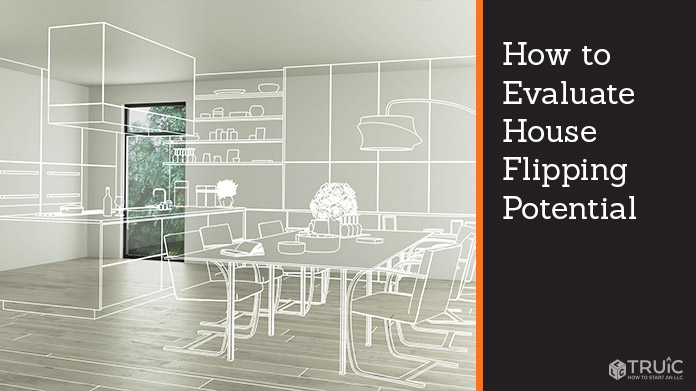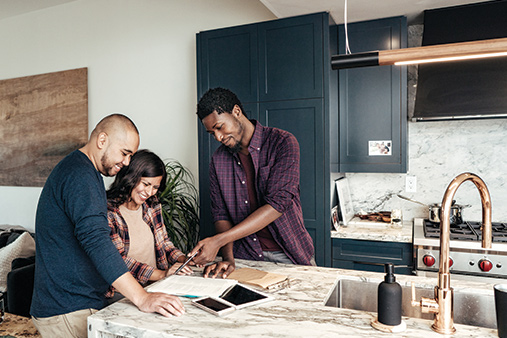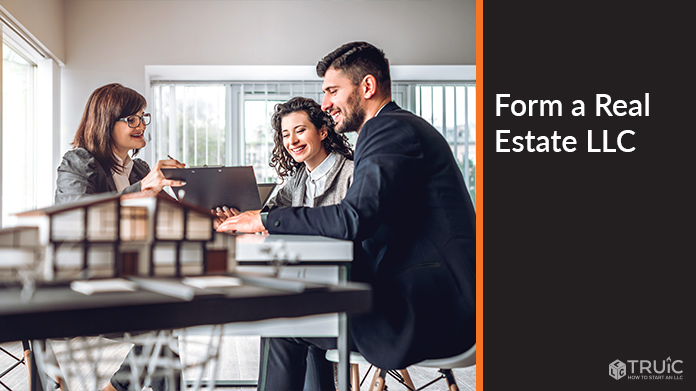How to Evaluate House Flipping Potential
Smart real estate investors make profits by successfully analyzing house flipping potential. Risk-takers lose their profits by rushing through this stage.
In real estate investment, you often have to make quick decisions. Research and preparation will help you to quickly evaluate house flipping potential and ensure you make the right decision at every opportunity. Read on for the best strategies to evaluate house flipping potential.
Recommended: Learn how to start a house flipping business with our guide.

Evaluate House Flipping Potential in 4 Steps
1. Narrow Your Search
As the saying goes, it’s all about “location, location, location.” You want to narrow your search to the neighborhoods that have the greatest house-flipping potential. By researching ahead of time, you have the target clearly set to maximize return.
To select the ideal target neighborhood, it should meet six key criteria:
- Good sales activity of homes
- Selling price of the homes
- Ages of the homes
- Charm and desirability of the area
- Safety of the neighborhood
- Vicinity of your work and home
Sales Activity
You are looking for a neighborhood that has homes selling quickly. If you aim to flip a house in three to four weeks, you want a sales market that is moving. Most homes finished to a similar standard should be selling within a few weeks. A neighborhood where renovated homes are sitting on the market for months will not be a good target neighborhood.
In sales activity, you are not only looking for quick sales. You will also want to locate a neighborhood that offers distinct price points, so you can buy at the lower price point and sell at the higher price point.
Selling Price of Homes
You should look for a neighborhood in the median price range. This price range has the largest number of potential buyers. House flipping in the median price range offers the best balance between risk and return. You get a higher return than with low-end house flips, without the increased risk of profit loss. You get a lower return than high-end house flips, but you avoid the burden and risk of high-end improvement costs.
Mid-priced houses will offer the best balance of risk and return.
Ages of Homes
Again, you are looking for the middle ground. A 100-year old home that needs a new roof and new plumbing will be too expensive and time-consuming to quickly flip. A 5 to 10-year-old home likely doesn’t require enough upgrades to buy under market value.
Look for a home that is 20 to 30 years old that requires mostly cosmetic modernization and can be done in three to four weeks maximum. You’ll be able to maximize your profit in minimal time.
Charm and Desirability of the Neighborhood
A great neighborhood for house flipping is an up and coming neighborhood that has charm and good amenities. Look for family-friendly neighborhoods with good schools, shopping, parks, recreational facilities, and plenty of retail and office space. Good public transport, easy commutes to larger cities, and low crime are all hallmarks of a great neighborhood. Proximity to universities and major business centers are other signs of a great neighborhood.
Safety
Choose a neighborhood where you feel safe. Check police and local records. Talk to locals. If you feel safe, potential buyers will as well.
Proximity to Home and Work
You don’t want to spend hours driving to and from your target neighborhoods to check for new houses to flip or meet with contractors on houses you are flipping. Choose target neighborhoods that are near your home, work, or between the two.
Step 2: Calculate Your Maximum Purchase Price
To calculate your maximum purchase price, you will use what is called the “70% rule.” The 70% rule is a simple estimation tool used by house flippers to quickly spot a good investment.
According to the 70% rule, you should buy a property at 70% of its after repair value minus repair costs.
For this, you will need to accurately calculate repair costs. However, in the initial assessment stage you can make an estimate. It is best to have contractors help you to make these estimates unless you have considerable renovation experience.
Renovation costs increase with the complexity of the work. Some examples include:
- $5 per square foot for simple renovation like new paint and carpet
- $10 per square foot for somewhat more complex renovations
- $15 to $20 per square foot for complex changes including new kitchen, bathroom, etc.
- $40 or more per square foot for major renovations involving electrical, plumbing, roof, etc.
Keep in mind that these are general estimates that will vary by area, how much of the work you do yourself, and the individual project. These prices provide a gauge to begin your estimate with local contractors.
Putting the 70% Rule to Work
Here is a simple example of the 70% rule:
- You plan to purchase a 1,500 square foot house for $140,000 and perform improvements like new paint and new carpet.
- You want to sell the house for $220,000 after improvements.
- You estimate that the improvements will cost $7 per square foot.
Therefore, you calculate that $7 x 1,500 square feet is $10,500 in improvement costs.
To apply the 70% rule, you take your final sale price of $220,000, deduct $10,500 and then multiply by 70%.
$220,000 – $10,500 = $209,500
70% of $209,500 = $146,650
This means that with your final sale price and the renovations you plan, your maximum purchase price will be $146,650 on this house. Generally, the 70% is a conservative estimate to ensure a good profit on the house flip.
Step 3: Calculate Your Maximum Offer
Once you have a general estimate with the 70% rule, you will want a detailed calculation of your maximum offer. You can do this by gathering information on four key components of the house flipping process.
Successfully using this formula depends on realistic calculations of each step. It is better to double-check each step several times than to make a mistake in your estimates and lose profit later in the renovation.
Factors you will need to account for in your maximum offer:
- Eventual selling price
- Improvement costs
- Operational costs
- Your minimum profit
Let’s look at how to calculate each of these in detail before creating a sample maximum offer.
Eventual Selling Price
The after rehab selling price is how much you can reasonably expect to get for the house after it is renovated. If you have done your research on the target neighborhoods well, you will have a clear idea of this.
For example, houses in your target neighborhood are selling for either $100 per square foot or $200 per square foot. In this case, after renovations to a comparable standard, you can reasonably expect to get a price around $200 per square foot.
However, it is important to be realistic in the value of the house you are flipping and the improvements you have made. Make sure you have reached or exceeded the standard of homes in that price range. If the selling price range at the higher end is $190 to $210 per square foot, take the lower price for this estimate.
It is better to err on the side of caution than risk losing your profit.
Improvement Costs
Accurately estimating improvement costs is one of the single most important steps in house flipping. You will need to classify improvements as must-do and could-do. You will also need to get inspectors in to confirm that the roof, structure, electrical, plumbing, etc. are sound.
Must-do improvements involve the security and safety of the home as well as the basic comfort and cleanliness of the home. Common sense is a good starting place. Would you want to live in a home like that?
Some of the improvement must-do renovation categories include:
- Windows and doors work properly and close
- All locks function well
- Stable foundation
- Undamaged rafters and roof
- Walls aren’t crooked or bulging
- Chimneys, porches, patio, and stairs are all in good condition
- Adequate drainage
- Clean and dry basement
- Clean and repaired gutters
- No signs of pests such as termites, fleas, spiders, wasps, rodents, etc.
- Repair exterior carpentry
- HVAC system is in good condition
- Plumbing is working and in good repair, without leaks, slow drains, etc.
- Electrical system is in good repair
- Smoke detectors work
- Repair all interior carpentry
- Repair and repaint walls
- Repair floors and countertops
- Update appliances
- Improve landscaping
For the finishes, you can choose between basic inexpensive finishes, standard finishes, or designer finishes. It is important to keep the finishes and appliances aligned with your final budget, the quality of the home, and the neighborhood. You don’t need to put high-end designer appliances in a mid-priced home.
To accurately estimate improvement costs, you can consult contractors for estimates as well as make your own calculations. Go over these costs two or three times, and be sure to calculate in a margin of error of about 10% to 15% for any unforeseen costs.
Operational Costs
Operational selling costs are the most often overlooked costs when house flipping. Operational costs are the costs of buying and holding the house. This includes brokerage fees during purchase and sale, interest on loans or mortgages, and the weekly or monthly expenses to maintain the house during the flip.
Operational expenses are the cost of doing business. It is the money you need to get started, and the money you pay in fees, interests, and loans after the final sale. The operational costs are the costs associated with making money through house flipping.
While the operational costs should not be a large portion of your total expenses, they also should not be overlooked. Of course, the longer you hold a home the more interest on loans will increase, increasing your overall operational costs. That is why a quick house flip is ideal and why finding a good neighborhood to ensure a short sale is so important.
Your Minimum Profit
Finally, you will want to calculate your minimum profit. This is the minimum amount you are willing to get out of a project to feel that your time and effort were adequately compensated. This can be a percentage of the original investment or any other target you set.
While some investors will simply start house flipping without a target profit, you run the risk of making little to no profit for your effort. A wise house flipper calculates minimum profit before purchasing a house to flip.
Return on Investment Models
The minimum profit, or minimum return on investment (ROI), is calculated as 10% of the eventual selling price. If you plan to sell a house for $300,000, your minimum ROI will be $30,000.
Calculate for Increased Risk
If you plan to take on more complex renovation work, beyond new floors and painting the walls, you will need to add in a percentage to your minimum ROI because you are increasing your risk. For every additional $5 per square foot you plan to put into renovation, you should add 1% to your minimum ROI.
For example, if you plan to sell a home for $300,000 after you add $40 per square foot of improvement costs, the new minimum profit would be as follows:
Minimum Profit for Increased Repairs
When putting these calculations together, you can reach your minimum profit figure.
Minimum ROI:
$30,000
Improvement costs per square foot:
$40
Divide improvement costs by increments of $5:
$40 ÷ $5 = 8
Percentage to add to ROI: 8%
10% original ROI + 8% = 18% new minimum ROI
Multiply home sell price by new minimum ROI percentage
$300,000 x 18% = $54,000
Calculated on sale price of $300,000, the new minimum ROI is $54,000.
In this example, the amount of $54,000 will allow you to recover the initial investment as well as the investment in repairs and still make a profit.
This formula ensures you are well compensated for risk and are able to make a comfortable profit on every house flip. Smart house flipping starts with evaluating house flipping potential.
Step 4: Putting It All Together
Now it is time to combine all these factors to calculate your maximum offer. The formula is very simple:
Eventual Selling price (Step 1), minus improvement costs (Step 2), minus operational costs (Step 3), minus minimum profit (Step 4).
This will be your maximum offer.
Example:
- Eventual Selling price: $350,000
- Improvement Costs: $25,000
- Operational costs $7,000
- Minimum profit $42,000
In this example, $350,000 – $25,000 – $7000 – $42,000 = $276,000
Your maximum offer price on this property will be $276,000.
Conclusion on Maximum Offer
If the house is selling for $300,000 and the seller will not come down in price, you know that this house does not have house flipping potential at that price. However, if the seller is ready to sell for $260,000, you know the house has good house flipping potential.
Using the Maximum Purchase Price Estimate
You can double-check your figures by using the 70% rule. You should buy a property at 70% of its after repair value minus repair costs.
When applying the 70% rule to this example, your maximum purchase price equation is:
$350,000 – $25,000 (improvements) = $325,000 x 70% = $227,500
Note that this number is significantly lower than your maximum offer price – almost $50,000 in price difference. You will have to evaluate which model more accurately represents your situation.
If you did all the calculations carefully for the maximum offer price, that is the more reliable model. However, when there is such a large difference in the two calculations, it is worth going back and double-checking all your numbers. You should feel confident in your calculations and the overall potential profit of the project.
In our example, if you are able to purchase the property for $227,000, you can be sure of an excellent profit on your house flip.
Summary
With preparation and research, you are positioned to quickly evaluate house-flipping potential. This will help you to take advantage of the best opportunities as they arise and to actively seek out houses to flip. Familiarizing yourself with the prices and trends in your target neighborhoods is an important first step.
Within your target neighborhoods, calculating your maximum purchase price and offer price are the tools to quickly evaluate profit margins on any real estate investment. Extra steps in assessment, accurate estimates of repair costs, operational costs, and minimum profit reduces your overall risk. With these tools, you are prepared to evaluate house-flipping potential and to take advantage of the offers with the greatest return.
When used together, these tools help you evaluate house-flipping potential. You have the flexibility to calculate the possible return on different levels of renovation. These steps of evaluation take the chance out of real estate investment and ensure consistent returns from your first house flip.


